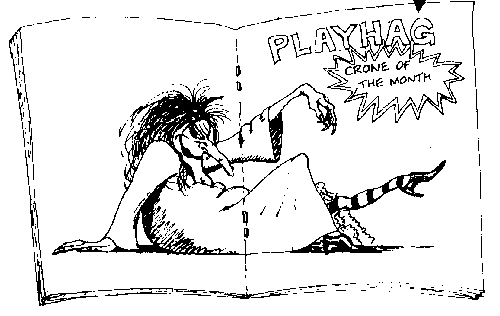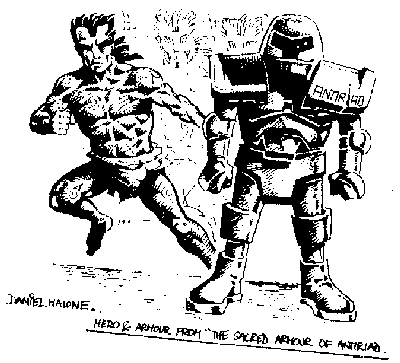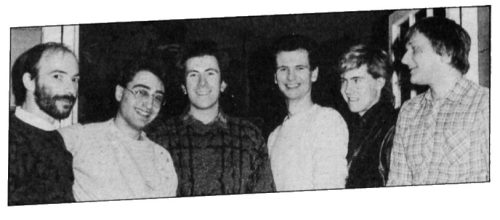
Since July last year, when Palace Software collected a CRASH Smash for CAULDRON, the team working in the Scala Cinema have been busy laying plans for the future. Three launches are scheduled for 1986 — the first of which is a follow up to CAULDRON, by the name of CAULDRON II, THE PUMPKIN’S REVENGE. It’s early days yet, with the Spectrum games not due for a good few months — but we took the opportunity of

Cauldron II — The Pumpkin Strikes Back carries on from where Cauldron left off. Having defeated the evil Pumpking, seized the golden broomstick and became Witch-Queen, the Hag no longer lives in her dilapidated cottage but has moved to a huge castle at the edge of the forest. You play the part of a small pumpkin, who was in fact the Pumpking’s guardian in Cauldron, and must recover the golden broomstick from the clutches of the oppressive Hag.
Work on the Commodore version is proceeding apace, and although the core of the game has been implemented on the Spectrum, the graphics and finished game are still a fair way off. A July launch is pencilled into the Palace diary. Once again, Steve Brown, the artist behind Cauldron is responsible for the graphics that appear in the game and the packaging artwork.
Steve joined Palace in late 1984 coming from a background in commercial illustration. Most of his work was for advertising agencies, although he has produced a few covers for White Dwarf by way of light relief. He came to art late in life, starting at art college in his mid twenties after spending a while doing a variety of things... now he’s firmly settled with Palace, producing stylish graphics on the computer screen.
The Sacred Armour of Antiriad is due for release after Cauldron II, and comic strip artist Dan Malone is the man taking care of the screen images on this project. Dan had never touched a computer until he started work for Palace Software last October, but has since designed a virtually complete storyboard for the game.

Pete Stone, the Big Cheese at Palace and co-founder of the company with Richard Leinfellner, decided that another artist was needed to take the pressure off Steve Brown if the company was to expand its portfolio of programming projects. George and Richard spent ages looking for the right person, interviewing lots of artists and they had almost given up hope when an art college lecturer who had heard of their search for a talented comic-book artist got in touch. She remembered that Dan had left his course at art college — he spent all his time sitting in the back of the class drawing comics — and recommended him for the job. Late last year Dan brought his portfolio to the Cinema and was hired immediately.
The Sacred Armour of Antiriad is set after the Holocaust in which humanity virtually exterminated itself. A few survivors went underground, regressed, and formed tribes worshipping the god Antiriad as personified by a humanoid form they hold sacred. However, the Elders of the tribes know the truth behind the legend — the great god Antiriad is nothing more than an Anti-Rad suit, used as protection against radioactive fallout during The War. At least the myth keeps their subjects happy.
Until They arrive, that is, and disrupt the social fabric. A group of aliens set up shop in a dead volcano, striking fear into the hearts of the savage humans and being generally unpleasant. Prayers to the god Antiriad achieve little, so the tribes turn to the Elders for advice. The Elders respond with the answer that the Sacred Armour of Antiriad is needed to repel the invaders.
A hero is chosen to recover the suit, penetrate the alien fortress and dispose of the threat. Which is where you will come in, around August time....
Dan’s talents for comic-book art have been applied to the design of the graphics, and his works should feature in the inlay — which will set the scene for the game in pictorial form.

The assembled crew from the Scala cinema. Left to right we have Richard Joseph, Stanley Schembri, Steve Brown, Dan Malone, David Quinn and Richard Leinfellner. The monkeys on the roof are part of the decor in the auditorium of the picture palace above which Palace has its nest
Palace Software has a third release planned for launch in early September. At the moment this game hasn’t got a title, but the programming team is to be BINARY VISION — a new company which has grown out of the Electronic Pencil company. Rupert Bowater and Paul Norris have left the EPC to set up on their own — the split is perfectly amicable, it’s just that they wanted to follow their own direction. This has taken them towards Palace and work has commenced on “a tropical escapade set between the First and Second World Wars”. Apart from that idiosyncratic (LMLWD) verbal description, there was nothing for us to view in the Palace Gallery, so we left the artists and programmers busy with their work and returned Ludlowards. (You try it!)